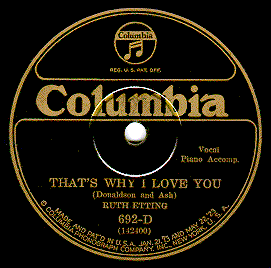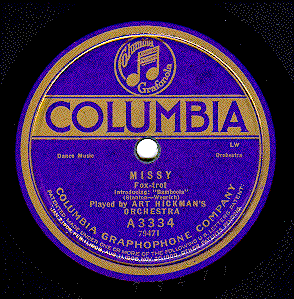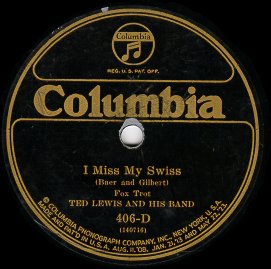
U.S. Pressing, 32mm ring, recorded 7/7/26 (Fig. 4)
[This article courtesy the "CAPS newsletter." Used with permission (sans figures and plates.)
 U.S. Pressing, 32mm ring, recorded 7/7/26 (Fig. 4) |
|---|
"The Columbia Graphophone Company of Canada was established in Canada around the turn of the century... Columbia disc records were probably pressed in Canada almost from the introduction of the disc record... Columbia tried to play a unique role in Canada during the first World War. There (was the Patriotic Series having a "P" prefix) with the Union Jack label... There was also an "R" series... a Canadian-only product not marketed or sold in the U.S.A....".
Brian also referred to the Canadian Columbia records that were pressed by Spartan in London, Ontario, beginning in 1940. He went on to describe the Columbia, Harmony, and Velvet Tone records that were issued in Canada. He hoped that his article would stimulate other collectors to engage in research and publish their findings. The present article was inspired by the pioneering work of Brian Boyd and the authors respectfully dedicate it to his memory.
Figure 1 shows the periods during which the Columbia group of records were pressed in Canada and the U.S.A. The authors stress that the dates are approximate. Columbia records were pressed in Canada up to 1931 when the Canadian branch became bankrupt. Clarion and Diva were not pressed in Canada; they were sold in the U.S.A. by chain stores which did not exist in Canada. In the U.S.A. Columbia ceased production of the Clarion, Harmony, and Velvet Tone labels in 1932. But production of Diva was ended in October 1930, probably the decision not of Columbia, but by the W.T. Grant Company, the chain store for which Diva was exclusively made. Harmony was pressed in Canada from the beginning of the Harmony label in 1925 until 1926. Velvet Tone was pressed in Canada from 1929 to 1931.
 U.S. Pressing, 80mm ring, recorded 1921 (Fig. 5) |
|---|
The American Columbia records show an indented ring on the label. We have been told by Joe Showler, an expert record collector and record producer, that this ring is called "the centre plate", and it is the mark of the head of the bolt that holds the stamper to the die in the press. The top bar of figure 2 shows that, up to 1925, the American Columbia records have an 80 mm ring. From 1932, they have a 70 mm ring. Between 1925 and 1932, they have a 32 mm ring.
| Years | 1921-1925 | 1926-1927 | 1928-1931 | 1932- |
|---|---|---|---|---|
| U.S.A. | 80mm | 32mm | 32mm | 70mm |
| Canada | no ring | no ring | 32mm | No Records 1932-1939 |
On the contrary, Canadian Columbia records show a 32 mm ring from 1928 to the end in 1931. But before 1928 a Canadian Columbia has no ring. By way of illustration, figure 3 shows an American Columbia with an 80 mm ring. It picks up the light just inside the gold-coloured circle near the outside of the label. Figure 4 shows an American Columbia with a 32 mm ring. It is easier to see because it is in the centre of the label. Figure 5 shows an American Columbia with a 70 mm ring. It is right at the gold-coloured circle near the outside of the label. It is difficult to see - quite deliberately. Columbia wanted to make the label look more attractive, compared to the label with the quite unattractive 32 mm ring right in the centre.
 Canadian Pressing, no ring, recorded late 1926 (Fig. 6) |
|---|
In summary, during the period 1921-1927 the significant difference between an American and a Canadian Columbia is that the American records have a ring, and the Canadian records have no ring.
Figure 2 illustrates the second difference - the absence of a stamper number. Beginning in 1924, all records of the Columbia group show a series of characters in the 12 o'clock position just outside the label. Figure 7 shows a typical example for an American pressing. The first character, the number "2", is the take number. The second character, the letter "B", designates the mother that was used to process the stamper. The third character, the number "4", is the number of the stamper that was used to press this copy. (Ref. Mahoney)
 The above record's wax: Stamper Present - Oops! |
|---|
In summary, during the period 1926-1931 the significant difference between an American and a Canadian Columbia is that the American records have a stamper number and the Canadian records have no stamper number.
The differences outlined above also apply to Harmony and Velvet Tone records. Specifically, a Canadian Harmony has no indented ring and a Canadian Velvet Tone has no stamper number, because of the years that they were produced - see figure 1.
Beginning in 1930, the labels of all Velvet Tone records, whether pressed in the U.S.A. or Canada, read "Reg. in Canada" and "Made...in U.S.A." These notations cannot be used to determine the nationality of the record. Figure 10 shows an example of a Canadian Velvet Tone.
The labels of most Canadian Harmony records read "Manufactured...U.S.A." In common with Columbia and Velvet Tone, these notations cannot be used to determine the nationality of the record.
However, Harmony has one unique feature that does identify certain records as Canadian. Figure 11 demonstrates this. In the U.S.A., the earliest Harmony labels, which we call label "A", show a price of "55c west of Rockies". Later issues, label "C", show no price. Figures 12 and 13 illustrate such American Harmony records; each has an indented ring.
Canadian Harmony records have the "A" label and the "C" label. There is also a "B" label, illustrated in figure 14. The labels show a price of "55c west of the Great Lakes" and specify "Mfg'd. in Canada". These records have no indented ring and no stamper number. This uniquely Canadian label was used for only a few months from late 1925 to early 1926.
We suspect that some West Coast Columbia pressings do not have an indented ring. However these can be identified by their distinctive type face so this does not present a problem for recognition. The authors have seen very few West Coast Columbia records and feel that this needs further research.
In summary the following rule seems to apply to virtually all records pressed by Columbia during the period 1921 to 1931:
 No ring, but stamper is present - Oops! |
|---|
Exceptions to these rules are some U.S. West Coast Columbia "Ds" which may also have a stamper No. missing. West Coast Columbias were pressed somewhere in California and may well be "wierd".
Barr, Steven C., "The (almost) Complete 78 rpm Record Dating Guide", (Toronto, ON, by the author, 1979.)
Barr, Steven C., "The Almost Complete 78 rpm Record Dating Guide II", (Huntington Beach, CA: Yesterday Once Again, 1992.)
Boyd, Brian, "The Columbia Phonograph Company of Canada", (Canadian Antique Phonograph Society Newsletter, Toronto: November-December 1991).
Mahony, Dan, "The Columbia 13/14000-D Series - A Numerical Listing", (Highland Park, NJ: Walter C. Allen, 1973).
Rust, Brian, "The American Record Label Book", (New Rochelle,.N.Y.: Arlington House, 1978).